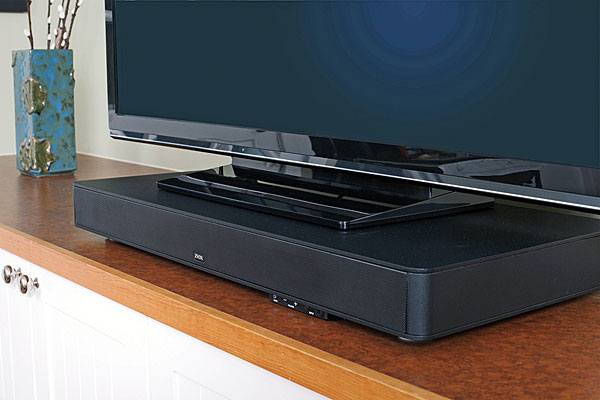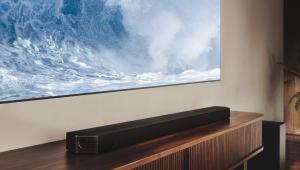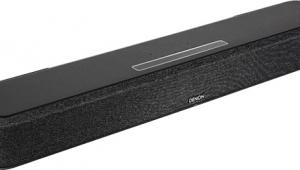ZVOX SoundBase.670

AT A GLANCE
Plus
Detailed, focused sound with tuneful bass
Excellent connectivity and feature set
Nice display
Minus
Can’t disable surround mode
Credit card remote
THE VERDICT
The SoundBase.670 proved itself a great all-rounder that’s at its best for movies and regular TV watching.
ZVOX created the TV soundbase category over a decade ago, but they’ve not been sitting on their heels for the last ten years. While other companies have only just jumped on the bandwagon with a soundbase of their own, ZVOX has continued to expand its offerings and up its game on sound quality and now has eight different soundbase models available.
The SoundBase.670 is the middle of three models of different sizes in ZVOX’s new top-of-the-line Platinum Series. The .670 accepts sets up to 70 inches and has five 2x3-inch front- firing, long-throw cones and three 5.25-inch down-firing woofers in a ported MDF cabinet; they’re driven here by a combined 105 watts of power. The smaller .570 ($350) handles up to 60-inch TVs and uses five 2-inch speakers and a single 5.25-inch woofer, while the big .770 ($600) can support a giant 80-inch set and offers a driver complement similar to the .670. So even though the SoundBase.670 isn’t the biggest model in ZVOX’s lineup, it is easily the largest of the three soundbases in this survey.

The .670 is also big on connectivity, with two RCA analog inputs on the back plus one 3.5mm analog input on the front panel, one coaxial and two optical digital inputs, and wireless Bluetooth capability with aptX codec compatibility. There’s also a stereo analog output, plus a subwoofer output just in case you want to add even more bass to the system. There’s a decoder for Dolby Digital signals but not for DTS, so you may need to set your disc player to output PCM digital when playing some Blu-ray Discs.
 Operating the SoundBase.670’s various features is relatively easy, because instead of trying to decipher what’s happening from a bunch of flashing LED indicators, you get a four-segment alphanumeric display that spells out exactly what you’re controlling. They even made the display orange so it appears much sharper from a distance than those fuzzy-looking blue displays that seem to be the norm these days. Sadly,
the remote is another one of those credit-card-sized jobs with the blister bump buttons, though the .670
can learn commands from your existing remote.
Operating the SoundBase.670’s various features is relatively easy, because instead of trying to decipher what’s happening from a bunch of flashing LED indicators, you get a four-segment alphanumeric display that spells out exactly what you’re controlling. They even made the display orange so it appears much sharper from a distance than those fuzzy-looking blue displays that seem to be the norm these days. Sadly,
the remote is another one of those credit-card-sized jobs with the blister bump buttons, though the .670
can learn commands from your existing remote.
Along with volume, mute, and input selection, the remote lets you control bass and treble in several steps. There’s also a dialogue enhancer called AccuVoice that really pumps up the midrange for those with hearing dis- abilities, as well as a volume leveler designed to reduce the volume swings between program content and commercials.
ZVOX’s proprietary surround mode is called PhaseCue and has been found in their soundbases since the very beginning. On the SoundBase.670 there are three levels of operation, though I would have liked having a way to turn the surround mode completely off, other than by switching to the midrange-boosting AccuVoice setting.
Choosing the best surround setting depends a lot on the source material. Most of the time, I settled on SD2 for music and regular television watching and SD3 for big action movies. I found that SD1 sounded too much like mono most of the time, while the other two settings added a pleasing sense of spaciousness and clarity. AccuVoice boosted the midrange too much for my taste and probably for most listeners, although it clearly did help voices cut through when they were buried in a noisy sound mix, such as during a sports broadcast.

Going back to the helicopter crash and lodge explosion scene in Skyfall, the SoundBase.670 had especially impressive bass. It wasn’t so much in how loud or deep it was, but the definition and tightness made it easy to separate the chop of the helicopter rotor from the roar of each explosion and the swell of the strings in the orchestral score. The ZVOX couldn’t play quite as loudly as the Vizio or even the Pioneer, but at full-tilt boogie, it never became ragged or distorted; it simply stopped getting louder.
Loud, punchy music like the Buddy Guy “Coming for You” track was also tuneful and dynamic, although ultimately the Pioneer delivered a more direct and engag- ing sound with slightly greater transparency. I appreciated the ZVOX’s ability to separate out the dual bass lines on Lou Reed’s “Walk on the Wild Side,” though it gave up a bit of the detail in the drummer’s brushwork. All told, though, the ZVOX was an all-around great performer and the most fully featured soundbase in this roundup.



























































